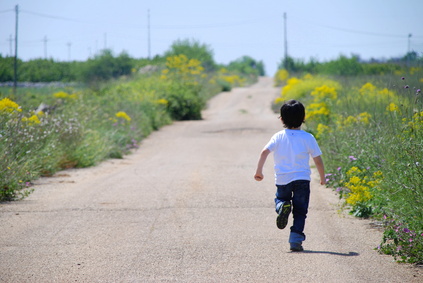 Time is precious.
Time is precious.
Time passes.
Time lost can never be recovered.
As autism parents, we are excruciatingly aware of time.
How helpful it would be if we could teach our children more efficiently, so that they could learn more skills in a shorter time. I’d like to tell you about Teaching with Acoustical Guidance, or TAGteach, an ABA-based method for increasing productive skills, and how it can help you teach a child more quickly and effectively.
Delayed Integration of Sights and Sounds in Autism
Children with autism often process sounds and sights, not simultaneously, but with a slight delay. When watching and listening to an instructor, the child with autism will see the lips and arms moving faster and will process the words more slowly. The child sees more action in less time and needs more time to decipher spoken words. It’s easy to see how this sensory and time disconnect would be a stressor for the child. It could result in speech problems, learning problems, frustration, and behavior problems.
So, how do you teach a child who is not experiencing his environment in the same time frame as we do? How do you make allowances? How do you provide effective supports to overcome this disconnect? I believe that TAGteach is a solution. The clear acoustical signal gets around the problems of sensory processing disconnect by providing precise, instantaneous reinforcement — in place of slower, traditional verbal reinforcement. The tag encourages the child to stay focused on what she is doing. No interruptions, no confusion, better learning!

How TAGteach helps children with autism learn
TAGteach enables extremely precise positive reinforcement of behavior by using an acoustical signal to “mark” the behavior – at the exact time the child performs the behavior! The acoustical signal is a short, sharp sound made by a handheld device (the “tagger”). When the child performs the correct action, the parent/instructor immediately presses the button on the tagger and hands over a treat (candy, treat, token, praise, social recognition, or money) as a reinforcer.
With TAGteach, it is easy to reinforce behaviors precisely, quickly and exactly on time. The immediate, accurate feedback and positive reinforcement result in the child performing the correct action more often, and for longer periods of time. With immediate feedback and learning tasks broken down into small steps, children (and adults) can learn many new skills with TAGteach — at their own pace.
A sound is better than verbal praise? Why?
Many people are still learning about the benefits of using a consistent sound, the “tag,” to mark a behavior. This is new to the mainstream, and often people wonder why a verbal comment like, “Good job” or “Yes, you’re right” isn’t as effective. Karen Pryor, internationally renowned author, and a pioneer in the development of force-free training methods, has a beautiful description of why an audible sound is much better at “marking” a behavior than our spoken words:
“…please note that the human voice is a very poor marker signal… too long, too slow, too variable, carrying too many confounding messages (your sex, your age, your mood, your health, etc.) and it also almost always late. Furthermore, you can’t distinguish when you are a mini-second late with your voice, but you CAN tell at once, without experience, when your click is late. (Karen Pryor, Penn State Listserve System, Standard Celeration Society, 18 May 2005.)
The tag delivers one message — success — without burdening the child with our slow words and personal emotional issues. Best of all — the the tag delivering this message on time!
To sum up, TAGteach lets you deliver reinforcement on time, so you can build skills more effectively. Time is a precious commodity in the life of a child with autism. We need to use our time wisely to teach a child as many skills as possible in the shortest amount of time.

TAGteach is easy to learn and easy to do. It is effective and low cost. It is a boon to families who need to teach their children the skills needed for everyday life. TAGteach gives parents an accessible, scientific way to teach new behaviors, rather than constantly managing or struggling with difficult and sometimes even dangerous behaviors. I recommend it to all parents for their consideration.
First published at the Behavior Station Guest Blog: The Behavior Station’s mission is to stay on track with ethical and professional standards of behavior analysis while transporting resources and mapping out science-based information as a means of guiding one to the best-supported platform on their life journey, regardless of the final destination.

For more information visit the TAGteach website.
Join the free TAGteach Yahoo Group.
TAGteach taggers are available here.
See Martha’s book about TAGteach for Autism or feel free to ask me a question (with no obligation).
Sign up for my mailing list to receive updates, new articles and free tips right in your inbox!
TAGteach stands for Teaching with Acoustical Guidance. TAGteach is a teaching and communication method based on the scientific principles of Applied Behavior Analysis (ABA).
TAGteach enables extremely precise positive reinforcement of behavior by using an acoustical signal to “mark” the behavior – at the precise moment the child performs the behavior! The acoustical signal is a short, sharp sound made by a handheld device (the “tagger”). When the child performs the correct action, the parent/instructor immediately presses the button on the tagger and hands over a treat (candy, treat, token, praise, social recognition, or money) as a reinforcer.
With TAGteach, it is easy to reinforce behaviors precisely and quickly. The immediate, accurate feedback and positive reinforcement result in the child performing the correct action more often, and for longer periods of time. With immediate feedback and learning tasks broken down into small steps, children (and adults) can learn many new skills with TAGteach — at their own pace.
For example, an instructor is teaching a child to follow directions and says, “Pick up the crayon.” If the child picks up the crayon, she is correct. If she picks up a pencil or eraser, or walks away, she made an incorrect response. With TAGteach, the instant her hand hovered over the crayon, the instructor would
“We have no time to stand and stare.” W.H. Davies, Welsh poet.
“… my time has been properly spent.” Ann and Jane Taylor, English writers. 1806.
“Time is fleeting.” Henry Wadsworth Longfellow. American poet. 1838.
There is one thing stronger than all the armies in the world, and that is an idea whose time has come. Anonymous.
Tick, tock, tag! Autism, teaching and time.
Articles: Simple Movement: http://www.sciencedaily.com/releases/2013/05/130508131829.htm
Sights and Sounds out-of-sync: http://www.huffingtonpost.com/2014/01/15/children-with-autism-sights-and-sounds-out-of-sync_n_4604231.html
Time Perception Different in Autism: http://autism.lovetoknow.com/Time_Perception_in_Autism_Spectrum_Disorder
Share the post "Tick, tock, tag: autism, teaching and time"












